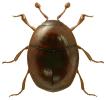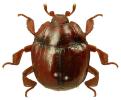Images:
The 2012 British list has 52 species of Histeridae (1-10mm long), in seven subfamilies. The family have truncate elytra, leaving the final two abdominal segments exposed, and characteristic geniculate (elbowed) antennae with terminal clubs. Generally strong-flying, quadrate species, most are carnivorous and are often found on carrion, where they usually arrive late and feed on other scavenging species. When disturbed, they fold their appendages into grooves on the underside and play dead, often for a long time.
Subfamily Abraeinae contains nine small (1-3mm) species, mostly associated with wood in various states of decay. An exception is Halacritus punctum Aubé, which is only found under seaweed just above the high tide mark. Teretrius fabricii Mazur, a predator of Lyctus spp. (Bostrichidae), has not been recorded in Britain since 1936 and may well be extinct here.
Subfamily Saprininae contains 16 2-7mm species. Most of the Saprinus and Hypocaccus spp. are found in carrion and dung. Myrmetes paykulli Kanaar is widespread but scarce and found in association with the wood ant Formica rufa L., while Saprinus virescens (Paykull) is a predator, probably of Phaedon and Gastrophysa larvae (Chrysomelidae).
Subfamily Dendrophilinae has 7 British representatives. Several can be found beneath tree bark, but additionally one Dendrophilus species, D. punctatus (Herbst) is found in bird nests and occasionally in association with the wood ant F. rufa, where it can be joined by Dendrophilus pygmaeus (L.). Carcinops pumilio (Erichson) is another carrion species (although it is also found in other decaying organic matter, particularly bat droppings and vegetation), while Kissister minimus (Aubé) is usually found amongst grass roots in sandy areas. Dendrophilus xaveri Marsuel is of Japanese origin, and rarely, briefly established in grain and flour warehouses in port cities, particularly Bristol, London and Liverpool.
Subfamily Onthophilinae includes just two species, Onthophilus striatus (Forster) and O. punctatus (Muller), which can be separated from other Histeridae by the presence of longitudinal keels on the elytra. Onthophilus punctatus is very localised in England where it is associated with subterranean mammal nests and runs, but O. striatus is common and widespread in dung and leaf litter.
Subfamily Tribalinae has only one British representative, the black 2-3mm length beetle Epierus comptus, found only under beech (Fagus sylvatica L.) bark in Wiltshire and Hampshire.
Subfamily Histerinae includes 16 medium-sized (3-11mm) British species, mostly rounded, and shining black, rarely with red patterning. Many are common in dung, carrion and rotting fungi, but Hister quadrinotatus Scriba and H. illigeri Duftschmidt are thought to be extinct in Britain. Margarinotus marginatus (Erichson) is a specialist of mole nests and is thus likely to be under-recorded. Hister unicolor Linnaeus and Margarinotus ventralis (Marseul) are most likely to be encountered in dung on pasture, whereas Margarinotus brunneus (Fabricius) is most typically found in carrion and Margarinotus merdarius (Hoffmann) in garden grass and compost heaps or in birds' nests in tree cavities. The rarely-encountered and usually strikingly red and black Hister quadrimaculatus Linnaeus, is restricted to the English coast in Hampshire and Kent.
Subfamily Haeterinae has only one British species, Haeterius ferrugineus (Olivier), a rare 1-2mm reddish beetle associated with ant nests, particularly those of Formica sanguinea Lat. in southern England.













